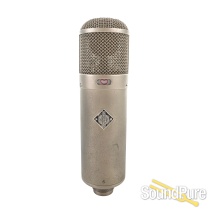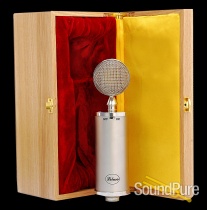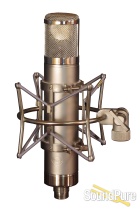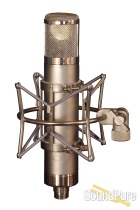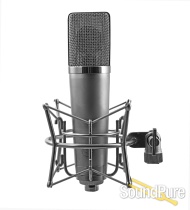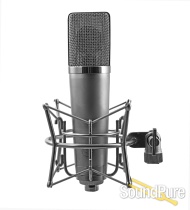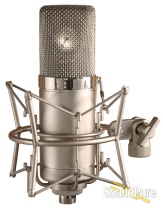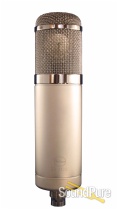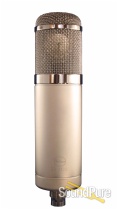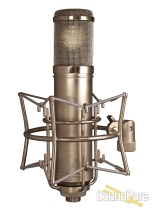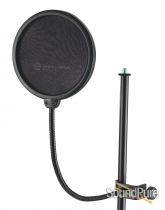-
Call Us Toll Free888-528-9703
-
Local/International (+1)919-682-5552
- Call Us! Toll Free! 888-528-9703
- Local / International (+1) 919-682-5552

What We Think
Priced with Suspension Mount, ask for different prices for different mounting options!
Manufacturer's Description from Gefell
The Tec Award nominated Gefell UM900 'Phantom' is a low-noise large diaphragm vacuum tube microphone with 5 selectable polar patterns that only requires 48V phantom for its operation. The distinctive appearance incorporates form and function, combined with a state-of-the art internal pre-amplifier for exceptional dynamics and detail. The result is a wonderful studio mic that is both easy to use and extremely flexible in operation, while retaining the warmth and smoothness that is associated with a vintage tube mic.
Design Features
Following the Gefell tradition of great sound without compromise, the 'eye' of the UM900 is the famous M7 dual membrane 1 inch (25mm), 24-karat gold evaporated capsule. Hand made using a PVC substrate, the Gefell M7 continues to set the standard for clarity, detail and reach that today is still unrivalled. The capsule is mounted on a triangulated pedestal behind a large 75mm head-grill. The side address grill differs from the usual cylinder or wedge-shaped design, which results in less field disruption while allowing the user to take full advantage of the 'proximity effect' to enhance the voice. The UM900's distinctive 'bottle-top' look is augmented with a carefully sculpted body that deflects unwanted refractions away from the capsule. This reduces phase cancellation and comb-filtering, which of course yields greater detail at the capsule, all of which play an important role in shaping the sound this microphone. Internal dampening reduces vibration borne noise further optimizes performance.
The heart of the Gefell UM900 is a miniature 'hearing-aid' audio tube and its unique phantom powering system. Using proprietary circuitry, an internal switching power supply generates voltages for the tube's plate and filament as well as the capsule polarizing voltage. Unlike traditional tube microphones, the UM900 Phantom does not require an external power supply box or multi-pair cable. At less than 4-milliamp draw, all that is required is the typical 48V phantom from any console or pre-amp. The clear advantage of 48V phantom powering is freedom.
The Gefell UM900 features three on-board control switches. At the front, a pattern selector switch offers choice of omnidirectional, wide-cardioid, cardioid, hypercardioid and figure-8 providing the user with tremendous options. Two additional control switches located at 120 off each side are used to control gain (-10dB, 0db and +4dB) and low-frequency roll-off (-10dB @70Hz). The unique +4dB gain setting works with the cardioid pattern to provide additional 'reach' in studio or live environments.
Using the mic
As with all world-class microphones, the Gefell UM900 may be used in a multitude of applications depending on the desired outcome. At better than 114dB dynamic range, and 140dB sound pressure handling, the UM900 is equally suitable for voice or soloing. Set back, the UM900 will astound the user for orchestral works and with the UM900's exceptionally low self-noise, it is truly ready for the greater demands imposed in the world of 24bit-96kHz recording. Hook-up is easy! Because the 'Phantom' does not require a special power supply, the UM900 opens the door to greater freedom in the studio or on stages allowing a tube mic to go where no tube has ever gone before! In fact, the transformer coupled balanced output allows the mic to be placed at distances of 150 meters (450 feet) without affecting the sound quality making the UM900 the singular choice for tube mic'ing on a live stage.
The UM900 may be factory ordered with choice of side mounted half-moon 130? swivel adaptor, deluxe elastic suspension or with a compact swivel mount. The half-moon incorporates isolation mounting while providing the user with the advantage of angling the mic towards the source. This factory-installed option provides maximum placement flexibility. The EA92 elastic suspension provides additional damping of external noise caused by vibration and is affixed via the machined base in the usual Gefell fashion. A swivel mount option is also provide for those that already have a compatible shock-mount or for mounting on stereo bar, Decca-tree, and so on.
Interpretation
The Gefell UM900 'Phantom' is a multi-pattern microphone that may be used in a multitude of applications without the 'ball & chain' restrictions of a designated power supply. These range from close-up mic'ing of solo vocals to overall pickup of an entire orchestra.
By combining the warm sound of a tube preamp with the legendary response of the Gefell M7 capsule, a wonderful balance between the natural presence peak and the extended bottom-end results in a very musical response. As Grammy Award winning engineer Alan Silverman put it: "..the sound of the UM900 is sparkling, enormous and exciting."
Exceptional sensitivity, low noise and great sound culminate in the UM900 as a true milestone in design, ergonomics and performance.
The Gefell M900 is available in an elegant satin nickel finish and may be special ordered in a dark bronze for reduced visibility requirements of television broadcast. A beautifully crafted limited edition custom 14-karat bright gold finish is also available. All mics come shipped in a beautifully crafted wood storage case.
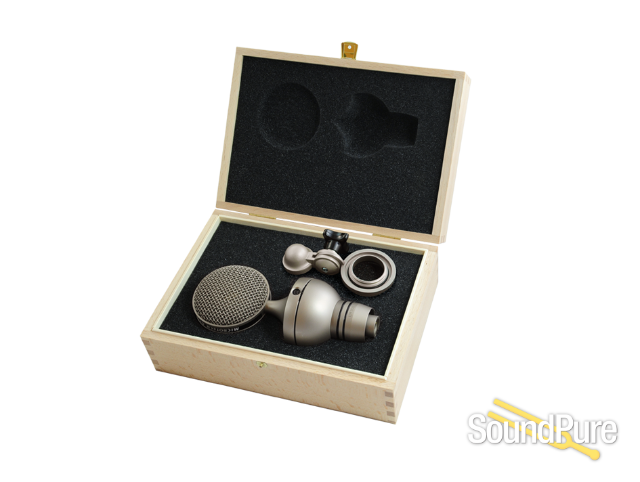
About Manufacturer
Since its founding by Georg Neumann in 1928, the company has produced high quality, condenser microphones for broadcasting and recording. Many models have used the M7 capsule originally designed by Mr. Neumann in 1949 for the CMV563a. The M7 was responsible for the legendary sound of the Berlin manufactured U47, U48 and M49 microphones. Today, under the technical supervision of Mr. Kuehnast's son, the Company still produces the M7 capsule in exactly the same way Mr. Neumann taught the elder Kuehnast in the 1940's. Hand drilling each hole in the backplate, making the PVC membrane, and even gluing it together by hand is done just as Mr. Neumann specified. The M7 is currently used in the UM 92.1S, UMT800, UMT70S and MT71S Gefell manufactured microphones.
Some of the production equipment which Microtech Gefell GmbH uses for capsule production capitalizes on advanced technology developed by the Soviets before Perestroika. One of the more recently developed microphones, the M300, uses a capsule made of ceramic material molded under high pressure and plated with chromium. This technology was developed in Moscow using advanced computer modeling and simulation techniques. Gefell perfected a capsule manufacturing process unlike any employed in making Western microphones.
The SMS70 series of microphones designed in the early 1970's used a hybrid amplifier with an fet stage. Hybrid technology was not adopted by manufacturers of Western microphones until the late 1980's. Microtech's newest amplifier for the UMT70S series microphones uses surface mount device (SMD) technology.
The company also manufactures a complete line of measurement microphones equivalent to those of Bruel & Kjaer, the Danish manufacturer. These microphones are tested to the highest standards currently used in the West. The manufacturing methods for the nickel membranes and backplate assemblies are highly advanced. Testing each microphone takes a minimum of three months to guarantee performance and stability when it leaves the factory.
Before the Reunification of Germany the company manufactured their studio and broadcast microphones for RFT, a state agency that distributed them to customers in the Eastern Bloc. Most of the microphones went into the broadcast system. Some microphones, like the PM 860, went into public address systems. Virtually every town hall and auditorium in the former Soviet Union has one. About 1985, the Company began developing high powered (30 to 100 Watt) industrial lasers. They still use a laser engraving machine to put the name and serial numbers onto microphones and other finished metal products. During this period, the East German government poured 60 Million Ost Mark into the company allowing them to buy sophisticated equipment and construct a new building.
Specifications
Pattern: Omnidierctional, wide cardiod, cardiod, figure 8
Response: 40Hz ~ 18kHz
Sensitivity: 40mV/Pa
Level / EQ controls: -10dB pad/-10dB@70Hz roll off
Signal to noise ratio: 6 dB-A
Maximum SPL: 140dB with 10dB pad
Dynamic range: 114dB
Power requirement: 48V phantom



